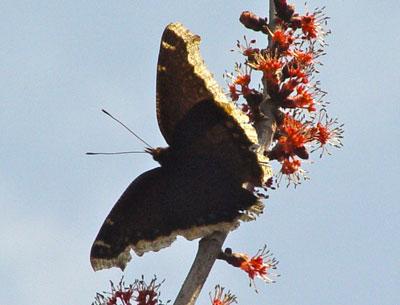Nature Notes: Mourning Cloak Is Risen

Well, we finally had a spate of spring-like weather. On Saturday, a phoebe was calling around my house, joining the two-week siege of grackle, redwing blackbird, cardinal, Carolina wren, and tufted titmouse calling and singing. Phoebes show up when the insects begin popping out, and they started popping out over the weekend like mad.
Among the first of these insects to appear is perhaps the prettiest, the mourning cloak butterfly, Nymphalis antiopa. This large lepidopteran, with its dark cast and white-margined wings and a lining of small black-ringed blue circles bordering the white, is the first butterfly by a long shot to make its appearance each year. Last year I saw my first in North Sea at the edge of an Atlantic white cedar bog on March 23. I was concerned that I hadn’t seen one this March despite many trips into wooded areas where they hang out motionless in a crevice or under the leaves until their spring emergence.
This year Easter Sunday fell on the last day of March, and during a walk along the Long Pond Greenbelt following the long-abandoned railroad line between Bridgehampton and Sag Harbor, there appeared out of nowhere a mourning cloak flitting here and there, as if to say, “Hey, I made it after all.”
Butterflies evolved about 40,000 years ago, a few hundred million years after the most common lepidopterans, the moths, appeared. The mourning cloak is probably much younger, but it has been on Earth long enough to spread its range across all of the Holarctic, from northern Asia through North America and throughout most of Europe. Interestingly, it is only accidental in the British Isles, but how it gets there year after year is an indication of why it has a range rivaled by few other butterflies, indeed, by few other species in the animal world.
It’s one of the few species of butterflies that overwinters in cold climes and thus it is one of the longest-lived butterflies, sometimes lasting an entire year. Was it some kind of omen that the mourning cloak appeared on Easter Sunday when another kind of cloak, the Shroud of Turin, was on display in the Vatican in Rome?
The name “mourning cloak” is a translation of the German name for this butterfly, “trauermantel,” or death cloak, after the traditionally dark attire worn by women in many parts of the world when attending funerals.
And for the mourning cloak, it’s a kind of second coming, after spending November through February and most of March almost completely lifeless. How can a butterfly that should be a nectar feeder emerge when there are but a handful of flowers, and none in the woodlands where it spent the winter, manage to survive? The mourning cloak has a special feeding niche used by hardly any other butterflies — it feeds on the sap exuding from the bark of trees. What is eerily ironic about the mourning cloak in the woods south of Sag Harbor on Sunday was the presence of another sap feeder in the immediate vicinity, a yellow-breasted sapsucker.
It was eerie because, as Vicki Bustamante was quick to point out, when we saw the mourning cloak on that March 23 Friday last year in North Sea, what was feeding in a tree twenty feet above it? A sapsucker. Is it possible that the sapsucker’s unmusical notes rouse the mourning cloak from its deep sleep? There may be a connection here that requires further investigation.
Well, as in almost every other fairy tale, the male mourning cloak finds a female, mates with her, and the eggs are laid in a willow, alder, or some other convenient tree, but one that leafs out early to give the attractively colored black and red caterpillars a head start over the other lepidopteran larvae that might be in the area, say, the gypsy moth or spring canker.
You can figure out the rest of the story on your own. The mourning cloak caterpillars mature by the end of summer, pupate, and hatch out into the “imagos,” adult mourning cloaks, which spend time searching for a good overwintering spot while getting by on sap, rotten fruit, and, on occasion, flower nectar. While the monarch and other butterflies are flying south with the snowbirds, the mourning cloak is perfectly content to spend the winter as I do these years, miserably cloaked in a dark blue bathrobe, resigned to riding out the numbing cold of these northern latitudes doing crossword puzzles and watching old movies.
